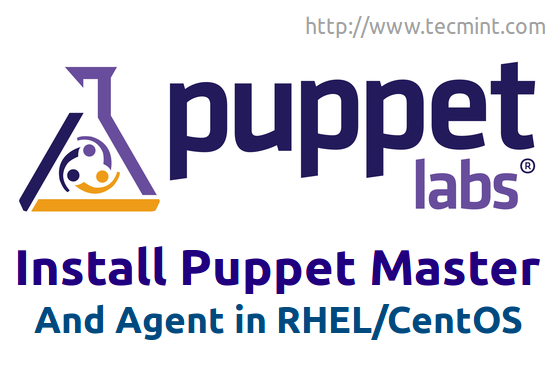Installing Puppet Master and Agent in RHEL/CentOS 7/6/5
Since the computer and computation came into existence the focus
remained on automating the task at certain level. Automating task refers
to completion of task mostly with itself with least or no human
intervention. Most of the fields of engineering be it networking,
aircraft, etc. implemented work automation in some form. Task Automation
aims at saving Man power, Cost, Time, Energy and accomplish task with
accuracy.
Automation at Server level is critical and automating task at server side is one of the most important task for every System Administrator. There are lots of wonderful tools available for System automation, but one tool which always comes to my mind is called Puppet.
The latest open source (community maintained) Puppet version <=2.7.26 was released under GNU General Public License.
Puppet
Project Aims at having an expressive enough language supported by a
powerful library. It Provide interface to write custom server automation
applications in just a few lines of code. Puppet has rich extensibility
feature with added functionality support as and when required. Last but
not the least it lets you share your work with the world as simple as
sharing codes.
3. Once channel is enabled, you can install latest versions of Puppet using Puppet Labs package repository on your correspondent RHEL/CentOS versions.
Do not start puppet master service now.
Do not start puppet agent service now.
Puppet: Post-Install Tasks and Configuration
Automation at Server level is critical and automating task at server side is one of the most important task for every System Administrator. There are lots of wonderful tools available for System automation, but one tool which always comes to my mind is called Puppet.
What is Puppet?
Puppet is a Free and Open Source software released under Apache License and developed by Puppet Labs for GNU/Linux, Mac, BSD, Solaris and Windows based computer Systems. The project is written in ‘Ruby’ programming Language and it is mostly used at server automation for expressing system configuration as well as a client and server for distributing it, and a library for realizing the configuration.The latest open source (community maintained) Puppet version <=2.7.26 was released under GNU General Public License.
Puppet Project Aims
Features of Puppet
- Designed in such a way that it prevents duplication for everyone solving the same problem.
- Mature Tool
- Powerful Framework
- Simplify System Administrator’s Technical Task.
- System Administrator’s task is written in Puppet’s Native code and can be shared.
- Makes it possible to make rapid and repeatable changes automatically.
- Maintains System Consistency and Integrity.
- Helpful in managing Physical and Virtual devices as well as cloud.
Step 1: Enable Dependencies and Puppet Labs Repository On Master
1. The server acting as a puppet master should have its system time set accurately. To set, accurate system time you should probably use NTP service. For more instructions on how to set correct system time with NTP, follow the below article.- Set System Time with “NTP (Network Time Protocol)” in RHEL/CentOS
3. Once channel is enabled, you can install latest versions of Puppet using Puppet Labs package repository on your correspondent RHEL/CentOS versions.
RHEL/CentOS 7
# rpm -ivh http://yum.puppetlabs.com/puppetlabs-release-el-7.noarch.rpm
RHEL/CentOS 6
# rpm -ivh http://yum.puppetlabs.com/puppetlabs-release-el-6.noarch.rpm
RHEL/CentOS 5
# rpm -ivh http://yum.puppetlabs.com/puppetlabs-release-el-5.noarch.rpm
Step 2: Installing and Upgrading Puppet on the Master Server
4. On your master server, run the following command to install Pupper Server, it will install an init script (/etc/init.d/puppetmaster) for executing a test-quality puppet master server.Do not start puppet master service now.
# yum install puppet-server5. Next, run the following command to upgrade Puppet to most newest version.
# puppet resource package puppet-server ensure=latest6. Once upgrade process completes, you will need to restart the puppet master web server to reflect new changes.
# /etc/init.d/puppetmaster restart
Step 3: Installing and Upgrading Puppet on Agent Node
7. Login to your agent node server and run the following command to install Puppet agent. Once you install Puppet agent, you may notice that an init script (/etc/init.d/puppet) has been generated for running the puppet agent daemon.Do not start puppet agent service now.
# yum install puppet8. Now upgrade the installed puppet agent to the most recent versions, with the help of following command.
# puppet resource package puppet ensure=latest9. Once upgrade completes, you will need to restart the puppet service to take new changes.
# /etc/init.d/puppet restartThat’s it! at this moment, your Puppet server and Agent installed successfully, but it isn’t configured properly, to do so you need to follow the post-install and configuration tasks at.
Puppet: Post-Install Tasks and Configuration


No comments:
Post a Comment